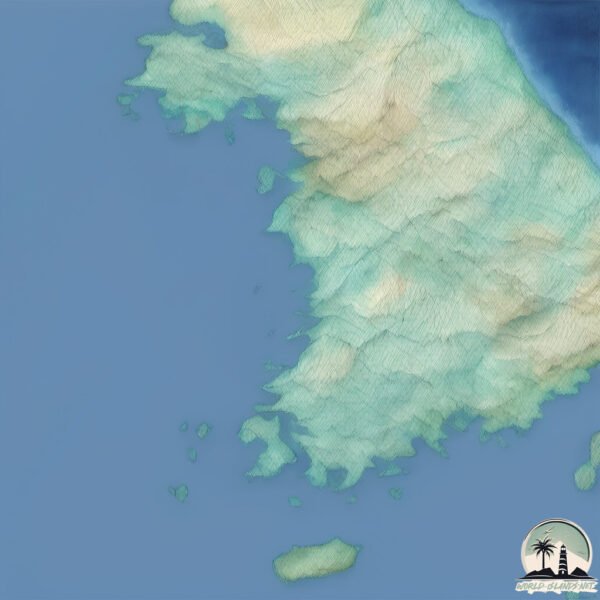Welcome to Modo , a Continental island in the Yellow Sea, part of the majestic Pacific Ocean. This guide offers a comprehensive overview of what makes Modo unique – from its geography and climate to its population, infrastructure, and beyond. Dive into the details:
Geography and size of Modo
Size: 1.075 km²Coastline: 4.9 kmOcean: Pacific OceanSea: Yellow SeaContinent: Asia
Modo is a Small Island spanning 1.1 km² with a coastline of 4.9 km.
Archipel: –
Tectonic Plate: Amur – A minor tectonic plate in the region of the Amur River at the border of Russia and China, involved in complex interactions with the Pacific and Eurasian plates.
The geographic heart of the island is pinpointed at these coordinates:
Climate and weather of Modo
Climate Zone: ContinentalClimate Details: Monsoon-Influenced Hot-Summer Humid Continental ClimateTemperature: Hot Summer
Climate Characteristics: Hot summers with monsoon rains, contrasting with dry, cold winters. Typical of east Asian continental edges.
Topography and nature of Modo
Timezone: UTC+09:00Timezone places: Asia/TokyoMax. Elevation: 14 m Mean Elevation: 14 mVegetation: Evergreen Needleleaf ForestTree Coverage: 96%
The mean elevation is 14 m. The highest elevation on the island reaches approximately 14 meters above sea level. The island is characterized by Plains: Flat, low-lying lands characterized by a maximum elevation of up to 200 meters. On islands, plains are typically coastal lowlands or central flat areas.
Dominating Vegetation: Evergreen Needleleaf Forest
Vegetation: 5 vegetation zones – Highly Diverse Island
Infrastructure and Travelling to Modo
Does the island have a public airport? no .
Does the island have a major port? no .
The mean population of Modo is 75 per km². Modo is Gently Populated. The island belongs to South Korea .
Continuing your journey, Yeongjongdo is the next notable island, situated merely km away.
The Jindo Sea Parting
This video was sponsored in part by Korea.Net: Korean Culture and Information Services. * *** Click to Expand *** Twitter: ...
The Jindo Sea Parting
This video was sponsored in part by Korea.Net: Korean Culture and ...
This video was sponsored in part by Korea.Net: Korean Culture and Information Services. * *** Click to Expand *** Twitter: ...
Modo Island in Incheon South Korea
Modo Island tour of Korean romance movie, Time. 한국 로맨스 영화 시간 촬영지 모도 여행.
korea #movie #travel.
korea #movie #travel.
South Korea is classified as Emerging region: MIKT: Mexico, Indonesia, South Korea, and Turkey – Economies recognized for their development potential and emerging market status. The level of income is High income: OECD.
News – Latest Updates and Headlines from Modo
Stay informed with the most recent news and important headlines from Modo. Here’s a roundup of the latest developments.
Loading...
Please note: The data used here has been primarily extracted from satellite readings. Deviations from exact values may occur, particularly regarding the height of elevations and population density. Land area and coastline measurements refer to average values at mean high tide.

